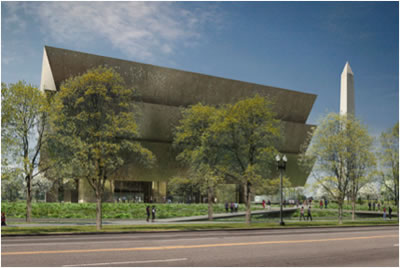
|
||
| FLATLINE | ||
Groundbreaking Museum Slated for National Mall
|
(Washington, DC) — On February 22, 2011, Washington celebrities, past and present, broke ground on what will be the newest Smithsonian museum in 2015: the National Museum of African American History and Culture (NMAAHC). The effort to open the museum has taken nearly a century, with African-American Civil War veterans trying to get the museum established around 1915. The NMAAHC will tell the stories and share the artifacts from the African-American experience. While the museum will reach back before the days of the Civil War, much of the attention will be paid to Reconstruction, the Jim Crow era, and the civil rights movement from the 1960s and beyond. The topics will include, but not be limited to, sports, entertainment and politics as it has historically pertained to African-Americans. "We've got it all covered," said a NMAAHC spokesman, speaking on condition of anonymity. "Politics will be housed in the Jesse Jackson Wing, highlighting Jackson's 1984 use of the term 'Hymietown' to destroy his presidential aspirations. "Violence against children will be retold in the Al Sharpton Wing, paying specific attention to his smearing of dog excrement on a teenage girl back in 1987, then lying about the incident and blaming members of the New York Police Department, all in the name of civil rights. "The museum will also tell the story of violence against women. The aptly-named O.J. Simpson Wing will allow visitors to see if the evidence does or doesn't fit from the 1995 trial. An animatronic statue of Chris Brown beating the holy hell out of Rhianna will be featured as well. "And, finally, the story of African-Americans in sports will, of course, mention Jackie Robinson and Muhammad Ali, but it will also focus on [Latrell] Sprewell's choking of Golden State Warriors coach [P.J.] Carlesimo, [Mike] Tyson's snacking on the ears of [Evander] Holyfield, the repeated drug use of [Adam] "Pacman" Jones and [Michael] Irvin, Ray Lewis' brush with murder, and other sports role models, especially from the past 25 years." "Ultimately, the National Museum of African American History and Culture should be a place of meaning, of memory, of reflection, of laughter, and of hope" said a NMAAHC spokesman, quoting NMAAHC Director Lonnie Bunch, speaking on condition of anonymity. |
 |
Groundbreaking Museum Slated for National Mall. FLATLINE 2012 Jan-Feb;14(1-2):e2.




